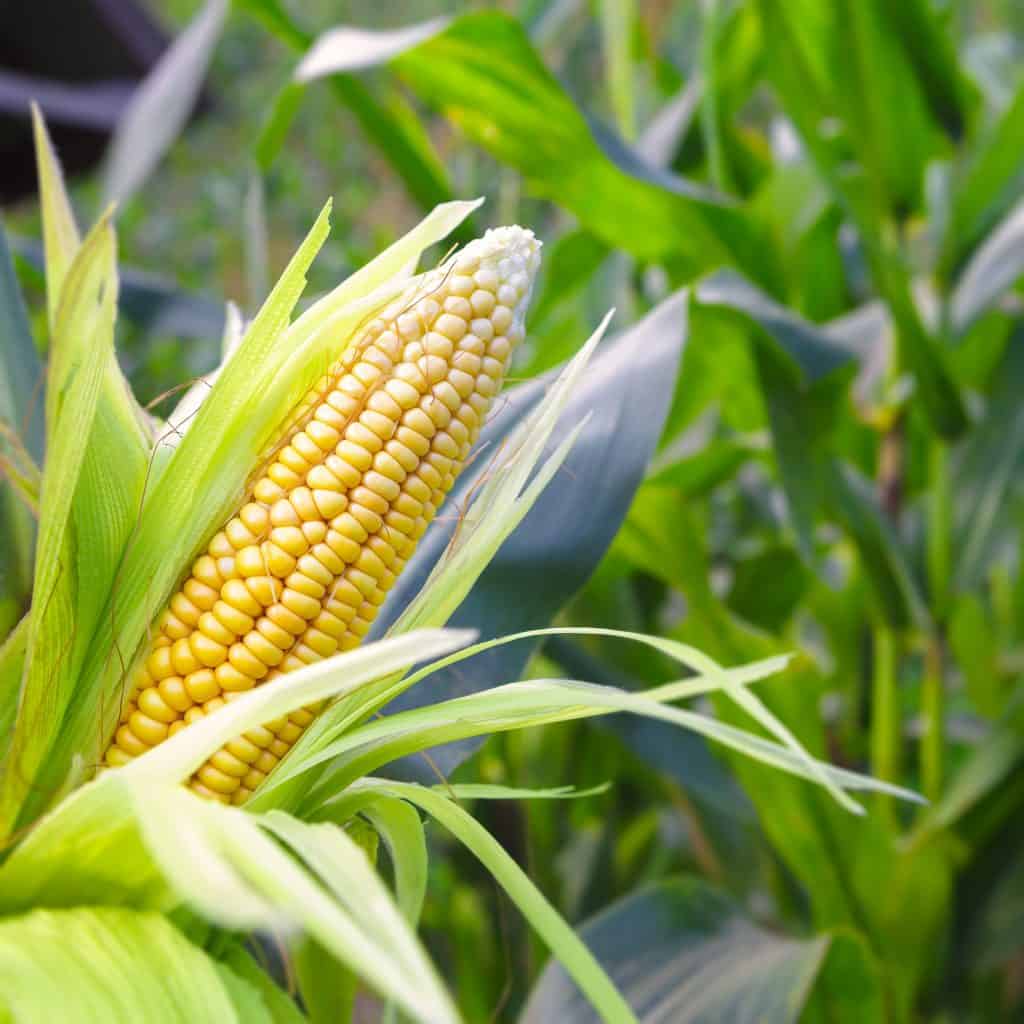
If you’re interested in catching a fish, you’ll always want to bait your hook with something tempting! This can include a variety of different lures or foods, and one of the most popular bait choices is corn. Before you decide to bait with corn though, let’s look at the consequences that choice might create.
Is it illegal to use corn as bait? The rules concerning bait vary, but in general, it is legal to use corn as hook bait. Certain states such as Oregon and Utah allow it as bait, but forbid its use in chumming. Although corn is attractive to fish, it can cause damage to them and their environment if used in excess.
The laws regarding using corn as fishing bait will depend on where you go. Below, we’ve included easy to read map showing which state it is legal to fish with corn. We’ll also take a closer look at the effects of corn along with some good bait alternatives.
Where is it Legal to Use Corn as Bait?
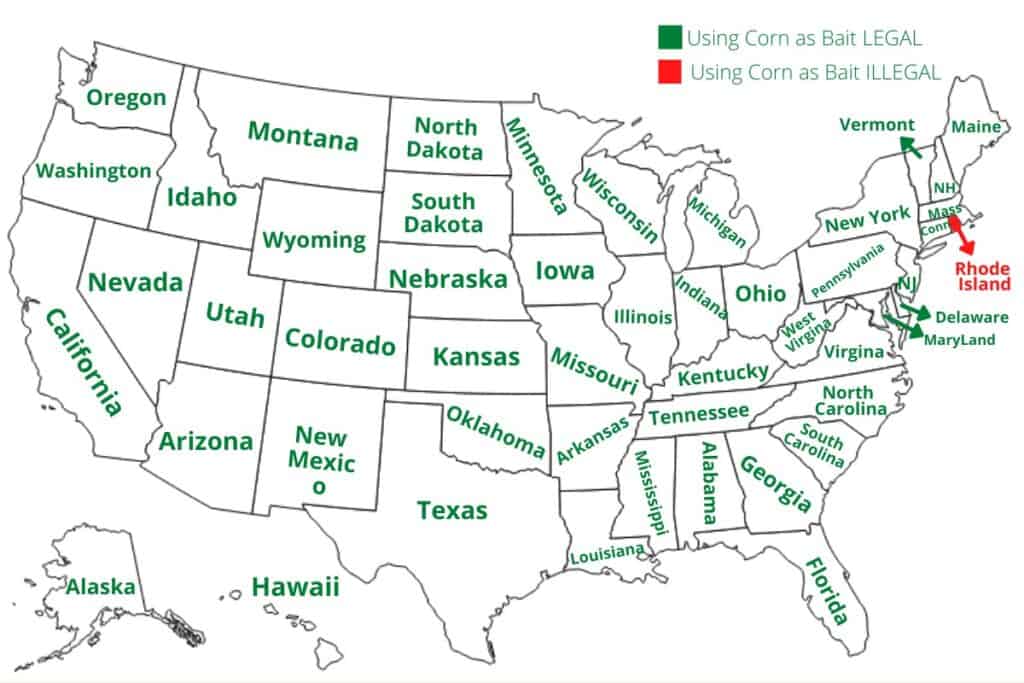
Where is it Legal to Use Corn as Chum?
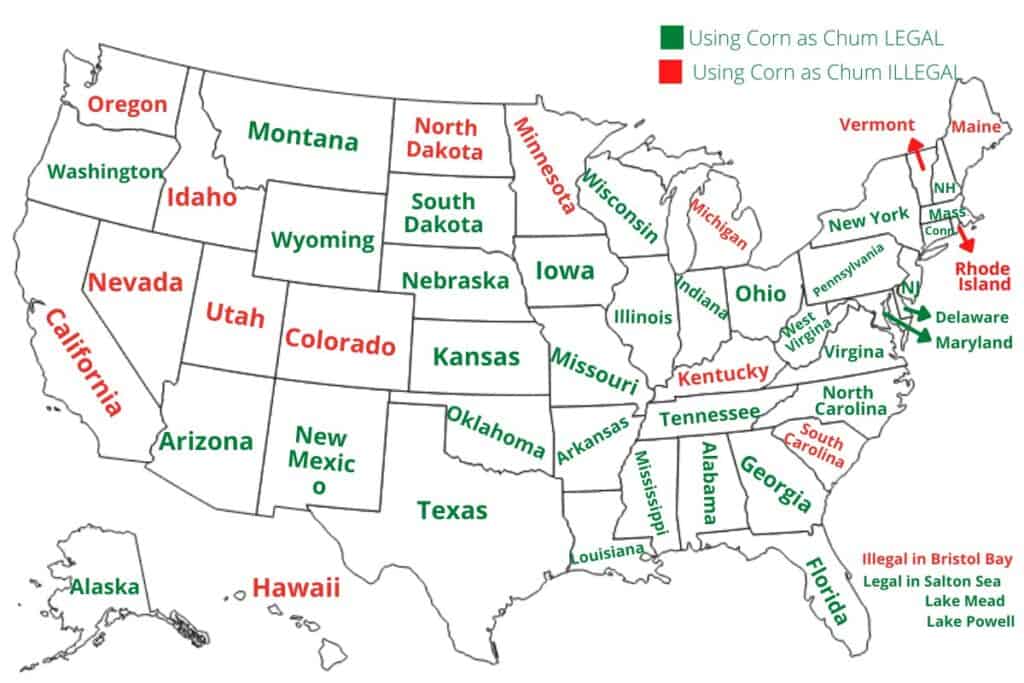
*Disclaimer: The maps provided are based on our best interpretations of the regulations for all 50 states. We advise that you check with your local city regulations before fishing. You can always call the fish and wildlife department to verify your findings.
Various State Laws
Since there are pros and cons to using corn as bait, different states have different policies regarding whether or not it is legal to use.
For example, in Oregon and Utah it is illegal to use corn to chum the water, but it is legal for hook bait. As listed above, chumming can cause long-term damage to the ecosystem and the plants and animals that live there.
Each of the 50 states have their own various rules and regulations when it comes to what can and cannot be used to attract fish. Although a few specifically forbid the use of canned corn, most states will allow corn to be used as bait as long as it is on a hook and only used within “bait waters”.
Bait waters are areas where organic bait is permitted. Bait-free waters are places that only artificial fly lures or metallic spin lures would be allowed. Depending on the state jurisdiction that each river and lake falls under, you should check what their individual rules might be.
If the area is privately owned or is part of a national or state park, the rules may also vary. Generally speaking, corn is legal to use on a hook, but it is rarely legal to use as chum.
So even though corn might be a convenient bait food to use, it has the potential to cause a great deal of harm to the fish you interact with and the ecosystem they live in.
The Consequences of Corn to Fish and Their Enviroment
Using corn to attract fish is usually a reliable way to get their attention. It has a bright yellow color, a distinctive smell, and comes in bite-sized pieces. All of these factors make corn an attractive snack for fish.
On the fisherman’s side, canned corn is cheap and easy to access. Most cans cost less than a dollar and are available at common grocery stores. This ease of access makes it tempting to use corn instead of worms or store-bought lures.
It’s also quite easy to stick a hook through a piece of corn without having to work too hard. Since the corn isn’t alive, it won’t fight back or struggle if you stab a hook through it!
Because of all these conviniences, it’s easy to see how corn has become a popular bait choice for many fishermen. And on first glance, it seems like a healthy option for the fish too, since it’s a naturally grown vegetable.
Corn can actually cause severe problems for fish and their environment.
However, corn can actually cause severe problems for fish and their environment. Although the corn is easy for them to swallow, it’s not always easy to digest. Corn doesn’t break down easily inside the digestive tract of fish (or even humans for that matter). It can take a long time to digest, and may even lead to deadly consequences.
If the fish is too small for the corn to pass through the stomach and intestines, corn can actually cause blockages and the fish could die from internal buildup. If this happens to too many fish, the mortality rate will go up for the area and there will be more decomposing bodies than the environment can keep up with.
Fish can also take a while to break down, so a collection of dead bodies can create a smell and sight that might ruin your scenic fishing trips in the future.
On an environmental scale, there are problems as well. Some fishermen like to use corn to “chum” the water. Chumming is a practice where certain kinds of food or bait are tossed into slow moving water to attract fish to that area. This increases the number of targets a fisherman has, and enables them to have more success in their casts.
However, chumming with corn can cause damage to rivers and lakes. Chumming is generally discouraged because it introduces foreign organic material to a natural environment. If enough people do this, it can throw off the water’s nitrate levels and alter the pH balance.
Altering water chemistry can affect everything that lives there, so it’s usually best to avoid this if possible. Since corn takes so long to break down, it can create a particular difficulty for the area’s decomposers.
Good Bait Alternatives
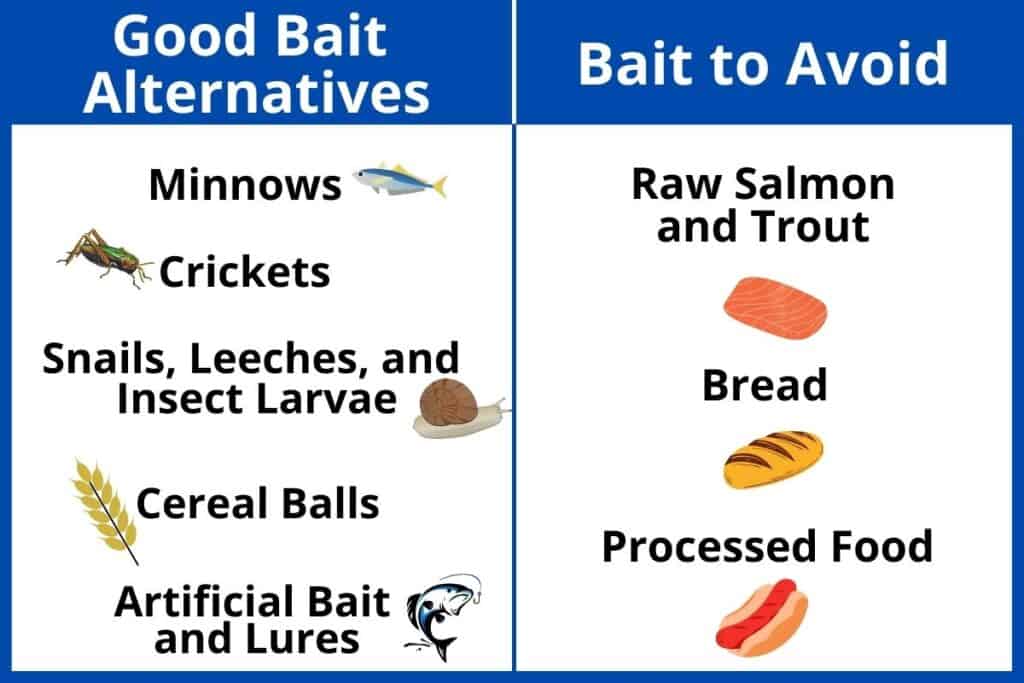
If you want to avoid the trouble of researching the rules and guidelines of every area you visit, there are some food alternatives you can use to attract fish.
Obviously, one of the most popular bait choices would be live worms. These have a distinct smell that fish can locate underwater, and the appeal of real, moving food is often hard for them to resist. Worms can usually be purchased from bait shops or fishing equipment outlets.
If you want to save a bit of money, you can also dig through your garden or flowerbeds to find some worms for “dirt” cheap! There will usually be a healthy population of earthworms around growing plants.
There are also household foods that many fish will be attracted to. Be sure to research the specific rules of each area you fish in to be sure that you’re not using foods that will be harmful to the environment. Small amounts of cheese, bacon, and raw meat can be great for attracting fish.
Fish will go for all kinds of different food. Some of their other favorites might include:
- Minnows
These tiny fish can be found in the shallow waters of many lakes and rivers. With a fine mesh net and a bit of patience, you’ll be able to catch a handful of these little fish to use as perfect live bait!
These can be used as bait whether they are dead or alive, but bear in mind the difficulties of each method. Live minnows may be small and difficult to attach to a hook. Dead minnows might dry out quickly due to their small size and be less appetizing to fish.
Either way, they are a natural food source for the area and most fish will take a snap if they get a chance.
- Crickets
Live crickets can be purchased at the majority of pet stores and bait shops. If they’re common around your area, you can also go out and catch your own. Fish may be more unfamiliar with this type of insect, but a kicking bug will definitely be sure to grab their attention.
- Snails, Leeches, and Insect Larvae
Several kinds of local creepy-crawlies will be appealing to fish. If you take some time to scout around the area you fish at, you should be able to collect a small sampling of localized prey. Flipping over river rocks is a great way to catch insects and larvae that might bring some interested fish your way.
Storing these finds in a small cooler of water can ensure that you’ll have a portable selection of live bait wherever you go. If you don’t end up using all of these by the end of the trip, you can also return them to their natural habitat and leave a smaller environmental impact!
- Cereal Balls
If you’re interested in making some homemade bait, this is a good way to go. Just start by pouring some cereal into a bowl and crushing it into rough flakes. Then you can use a bit of water, juice, or soda as a binding agent. This will make the flakes stick together and also give it a stronger smell for the fish!
You can then form them into little balls that will fit around a hook in the future. (You’ll want to give these time to dry after you make them, or else they will fall apart once they get wet).
Wheaties, or other fiber-rich cereals are the best kind to use, since they will produce stronger, hardier shards when broken.
- Artificial Bait and Lures
Finally, if you’re not interested in buying or catching live bait or crafting your own cereal bait, you can always go for artificial lures. Spin lures create flashes of light, motion, and color that can grab the attention of fish.
Likewise, dry fly fishing lures can imitate the appearance of insects landing on the surface of the water. Wet lures mimic small fish and aquatic insects.
There are multiple kinds of bait you can use to attract the attention of fish. These all come with different prices, pros, cons, and availability. When you’re choosing which bait is right for you, be sure you’re also following the rules for each area you go.
Bait to Avoid
Although you have many good types of bait to choose from, there are a few you should avoid. Each of these might not be technically illegal to use, but they can cause health problems to fish, and damage to the environment if they are overused.
- Raw Salmon and Trout
Although many fish are carnivores and can be attracted by the smell of meat and raw fish, using salmon and trout as bait can have severe consequences. These types of fish can host a dangerously contagious parasite called Myxobolus
If a fish dies in nature, this parasite can leave the fish and infect the water around them. They can also remain hidden in the meat of the fish and infect other fish that eat it.
If other fish ingest dead salmon or trout that are infected with this parasite, they can become affected by “whirling disease” and continue the spread of this dangerous disease.
There is no known cure for whirling disease, and it is often fatal to the fish that are affected by it. If it spreads too rapidly, it can make a major negative impact on the health and populations of various types of fish.
Not all salmon and trout are carriers of this parasite, but it should still always be avoided as bait to ensure that whirling disease is not introduced into a population.
- Bread
Using bread, rolls, pastries, or other baked goods can be dangerous to the fish and their surroundings. Most fish don’t have the proper digestive system to process bread, so it can cause damage to their bodies over time.
In addition, if soggy bread is left in standing water, fermentation and rot will take place. This will alter the state of the environment and could attract swarms of decomposers that are cannot be supported for long. (It can also create an unpleasant smell that definitely won’t improve your fishing trip).
- Processed food
Introducing food that is greasy, synthetic, or overly processed into a natural environment is not healthy for the organisms or the area. Nature isn’t equipped to break these types of food down very easily, and they can quickly go bad and spread throughout the water. Rotting food can also spawn unnatural swarms of insects and decomposers.
Most fish have fairly hardy digestive systems that are able to handle multiple different types of food. However even they have limits. Even though a fish eats something that doesn’t mean that it’s a healthy choice. Remember the consequences that introducing unnatural foods into an environment can cause.
Just because something is easy or convenient to use as bait doesn’t mean it will always leave a positive impact.
Other Fishing Laws You Might Not Know About
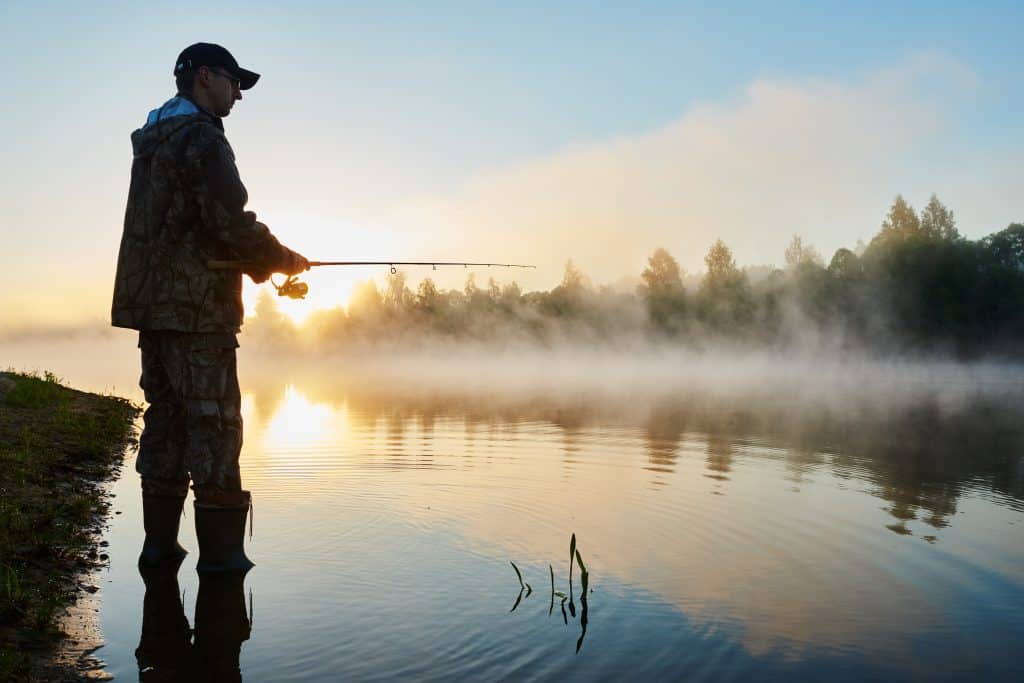
There are a lot of different fishing laws for every state. Some of them are straightforward, while others are obscure. Just to make sure you don’t break any laws by accident, here are five rules that are just random enough that you might want to try them if you didn’t know they were against the law.
- In Indiana and Kansas, it is illegal for anyone to fish with their bare hands.
So no matter how close that fish looks, no matter how catchable it may seem, you need to keep your hands and arms inside the fishing boat at all times. I would think that it was impossible to catch a fish this way if I hadn’t seen my own brother catch a fish bare-handed. So if you’re a resident of Indiana or Kansas, you’d better stick with a fishing pole!
2. In Kentucky it is illegal to fish with a bow and arrow.
Some people find it hard to wait for the fish to come to them and decide to take matters into their own hands. If you can see a fish ignoring your bait and swimming just out of reach, you may get the temptation to stick an arrow in it. Kentucky residents had better beware of this urge or pay the legal consequence!
3. In Ohio, it is illegal to get any fish drunk.
If you’re going for cheap fish bait, alcohol definitely isn’t on that list. Be sure that all of your bait will keep the fish sober, and you’ll save money on bait, and on a penalty fee.
4. In Pennsylvania, it is illegal to use dynamite to catch fish.
I think this one should go without saying, so it makes me wonder which pyrotechnic person made his law became necessary. Although explosives might yield an impressive amount of fish, it may also cause more damage than it’s worth.
5. In Tennessee it is illegal to use a lasso to catch fish.
In my opinion, fishing is hard enough without trying to include rodeo rope maneuvers! But even if that fish is looking big enough to lasso, you’ll need to put the rope away if you live in Tennessee.
All jokes aside, each state has its own regulations concerning what is and isn’t permitted when it comes to fishing. When you apply for a fishing license or are just doing a little internet research, you can look up what kind of bait, equipment, and techniques are and aren’t allowed.
Avoid unnecessary fines and penalties by knowing the rules of the area.
Varieties of Corn Used for Bait

Once you’ve decided which type of corn fish bait you want to use, you can either go to your local store that carries them or for more convenience, I’ll provide the links to where I purchase my corn bait.
Canned sweetcorn is easily found at grocery stores or online here. This is the Imitation corn and Flavored Corn Bait I use from Amazon. Lastly, the Feed corn I use can be purchased here.
Related Questions:
Can you use corn to catch trout? As with many types of fish, trout can be attracted by the sight and smell of corn. It has been shown to be effective in the past, though certain states forbid the use of “chumming” corn and restrict its use to hooked bait.
Is it legal to chum the water? Chumming is frequently used to attract sharks, and it is strictly regulated in this context. When it comes to fishing for smaller types of fish, the volume, material, and frequency of the chumming are subject to the regulations of the state.
